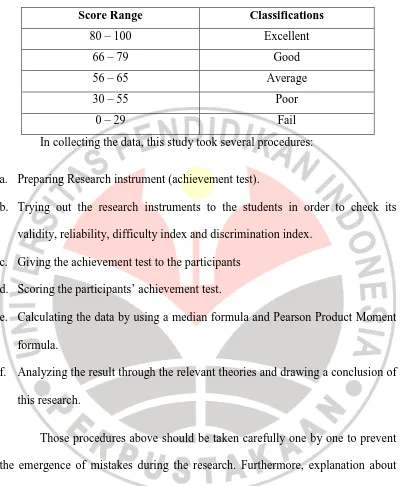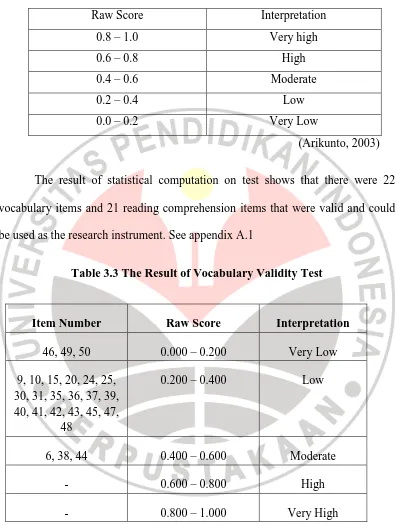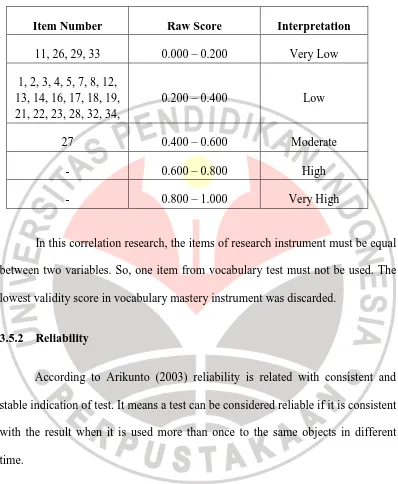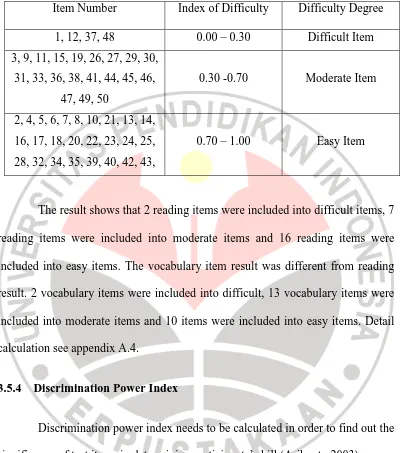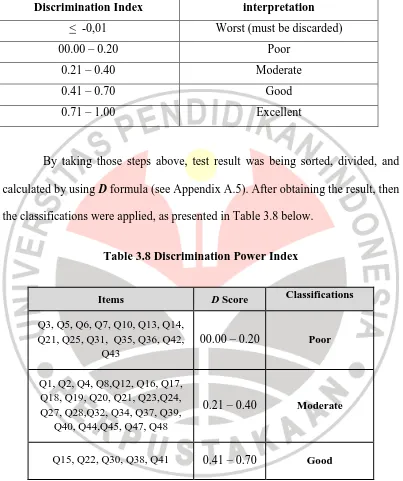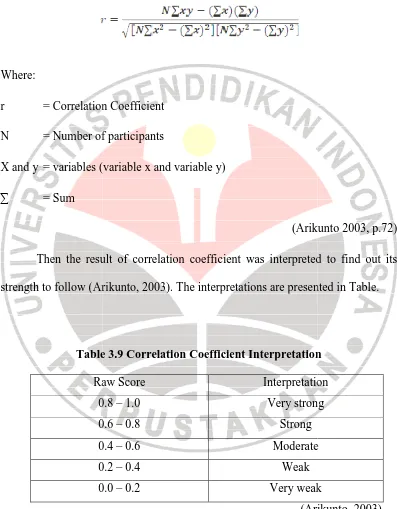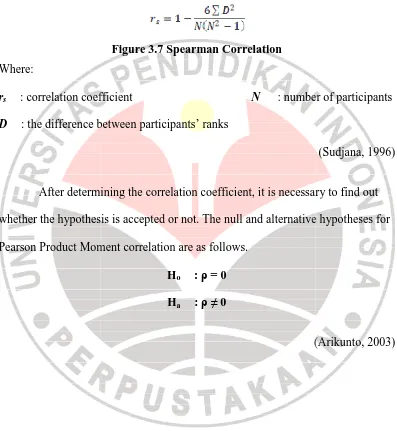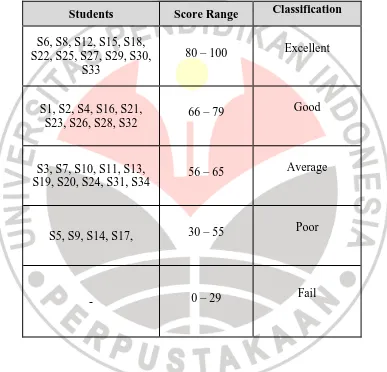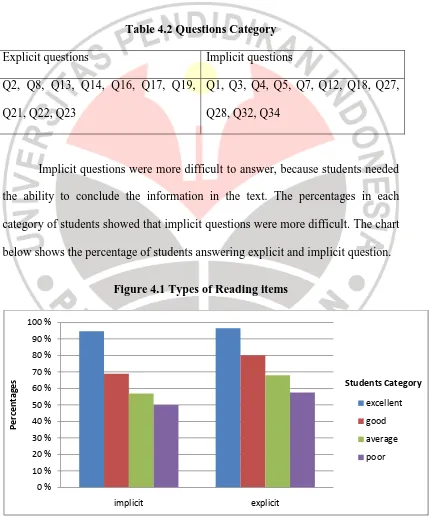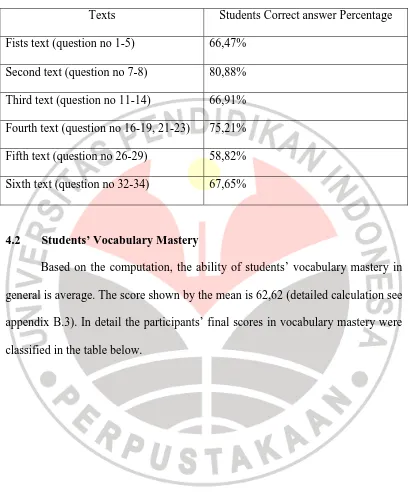CORRELATION BETWEEN STUDENTS’
VOCABULARY MASTERY AND THEIR READING
COMPREHENSION
(a study in second grade of junior high school)
FAJAR FURQON
0608773
ENGLISH EDUCATION DEPARTEMENT
FACULTY OF LANGUAGE AND ART EDUCATION
INDONESIA UNIVERSITY OF EDUCATION
CORRELATION BETWEEN STUDENTS’
VOCABULARY MASTERY AND THEIR READING
COMPREHENSION
Oleh Fajar Furqon
Sebuah skripsi yang diajukan untuk memenuhi salah satu syarat memperoleh gelar Sarjana pada Fakultas Pendidikan Bahasa dan Seni
© Fajar Furqon 2012 Universitas Pendidikan Indonesia
Desember 2012
Hak Cipta dilindungi undang-undang.
PAGE OF APPROVAL
CORRELATION BETWEEN STUDENTS’ VOCABULARY MASTERY AND THEIR READING COMPREHENSION
(a Study in Second Grade of Junior High School)
By
Fajar Furqon
0608773
Approved by
First Supervisor Second Supervisor
Prof.Dr.Hj. Nenden Sri L. M.Pd. Ika Lestari Damayanti M.A.
NIP. 195111241985032001 NIP. 197709192001122001
Head of English Education Department
Prof.Dr. H. Didi Suherdi, M.Ed
ABSTRACT
TABLE OF CONTENT
Statement ... i
Preface ... ii
Acknowledgement... iii
Abstract ... iv
Table of Content ... v
List of Figures ... viii
List of Table ... ix
CHAPTER I: INTRODUCTION ... 1
1.1 Background ... 1
1.2 The Scope of the Research ... 3
1.3 Statements of the Problem ... 3
1.4 Aims of the Research ... 3
1.5 Hypothesis ... 4
1.6 Significance of the Research ... 4
1.7 Research Method ... 4
1.7.1 Population and sample ... 4
1.7.2 Data Collection ... 5
1.7.2.1 Instrument ... 5
1.7.2.2 Research Procedure ... 5
1.7.3 Data analysis ... 6
CHAPTER II: THEORETICAL FOUNDATION ... 8
2.1 Definition of Reading ... 8
2.2 Reading Strategies ... 10
2.3 Reading Comprehension ... 13
2.4 Definition of Vocabulary ... 14
2.5 Related Research ... 16
2.6 Synthesis ... 17
CHAPTER III: RESEARCH METHODOLOGY ... 18
3.1 Research Design ... 18
3.2 Population and Sample ... 19
3.2.1 Population ... 19
3.2.2 Sample ... 19
3.3 Research Hypothesis ... 19
3.4 Data Collection ... 20
3.4.1 Research Instrument ... 20
3.5 Trying Out the Research Instruments ... 22
3.5.1 Validity ... 23
3.5.2 Reliability ... 25
3.5.3 Difficulty Index ... 26
3.5.4 Discrimination Power Index ... 28
CHAPTER IV: FINDINGS AND DISCUSSION ... 34
4.1 Students’ Reading Comprehension ... 34
4.2 Students’ Vocabulary Mastery ... 38
4.3 Correlation Coefficient ... 41
4.4 Testing the Suggested Hypothesis ... 43
4.5 Discussion ... 44
CHAPTER V: CONCLUSIONS AND SUGGESTIONS ... 48
5.1 Conclusions ... 48
5.2 Suggestions ... 49
REFERENCES ... 50
CHAPTER I
INTRODUCTION
Introduction
This chapter provides a brief description of the whole contents of the research, including the background of the research, scope of the research, statement of the problems, aims of the research, hypothesis, significance of the research, research method, organization of paper.
1.1 Background of the Research
Reading is one of the important language skills. By reading, people may get a lot of information. The more he/she reads, the more information he/she will get. Reading makes someone smarter and creative. As stated by Laddoo (2007) reading forces the reader’s brain cells to work on a regular basis as this will keep the reader sharper and smarter. Even though some information can be obtained without reading, for example by listening to teacher, seminar, radio, television etc, but by reading someone may get wider information than listening. For example, someone who reads a newspaper will get more information than someone who watches news on television. Reader can read the text again when he/she forgets or tries to get detail information, while listener cannot. This is supported by Willis (2008) who states that by reading, someone can find the information he/she needs with specific information.
happen (Klingner, Vaughn and Boardman. 2007, p.3). Another way to help the students to understand the text without knowing all the vocabulary in the text is by finding key words. It is in line with Lehr & Osborn (2001) who explain that to understand a text, we need to find the key words of the text. By doing this strategy, students can cover their vocabulary weaknesses since vocabulary knowledge is one of the major factors that influence reading comprehension (Roehrig and Guo, 2011).
One of the previous studies related to the relationship between reading comprehension and vocabulary mastery was conducted by Liu and Nation (1985). It is about the success of guessing meanings of a text. The results of this study show that the participants who have high reading proficiency level could successfully guess 85% to 100% of the unknown words, and the participants who have low reading proficiency level guess around 30% to 40% of the unknown words.
From the description above, the present study attempts to find out the correlation between the students’ vocabulary mastery and their reading comprehension and to find out how high the correlation between vocabulary mastery and reading comprehension is. The subjects of this research are the students of a junior high school in Bandung. The results of this study are expected to enrich the literature on research regarding to the relation of students’ vocabulary mastery and their reading comprehension.
1.2 Scope of the Research
This research focuses on finding out the correlation between reading comprehension and students’ vocabulary mastery in the 2nd grade of junior high school because they have learned several types of text. There are 34 students involved in the present research.
1.3 Statements of the Problem
The problems to be discussed in this research will be summarized in the following research questions:
1. What is the students’ mastery of reading comprehension?
2. What is the students’ mastery of vocabulary knowledge?
1.4 Aims of the Research
In accordance with the research questions, the aims of the present research are:
1. to find out the students’ mastery of reading comprehension, 2. to find out the students’ mastery of vocabulary knowledge, and
3. to find out the correlation between the students’ vocabulary mastery and their reading comprehension.
1.5 Hypothesis
When there is a correlation between students’ vocabulary mastery and their reading comprehension, the alternative hypothesis is accepted and null hypothesis is rejected.
1.6 Significance of the Research
The aim of this research is to find out the correlation between student’s vocabulary mastery and their reading comprehension in a junior high school. This study is also expected to give significant contribution to others, especially English teachers and future researchers. When the teachers know the correlation between vocabulary mastery and reading comprehension, it may help them to figure out some appropriate strategies in order to help their students to comprehend the texts.
1.7 Research Method
their reading comprehension. The research method used in this present research includes population, sample, data collection and data analysis.
1.7.1 Population and sample
The research was conducted at one of Junior high school in Bandung. The subjects of population were taken from the second grade students because they had learned several texts. There were 7 classes in this grade. Each class consisted of 34 students. The total population was 250 students. The researcher used one of the classes for this research. The students involved in this present research were 34 students. The subjects of this research were both male and female.
1.7.2 Data Collection
The technique used to collect the data of this study is achievement test. The selection of types of test test is based on the intention to screen students’ current knowledge and skills. Achievement test is a test meant to measure acquisition of skill (Algarabel and Dasi, 2001). Through this technique, the information about students’ ability in reading comprehension and vocabulary mastery is expected to be obtained.
1.7.2.1 Instrument
1.7.2.2 Research Procedure
The procedure of research is as follows.
1. Designing the achievement test by compiling test items from UAN 2006 - 2010
2. Giving the achievement test to the students to find out the students’ vocabulary mastery and their reading comprehension
3. Organizing the data by dividing the vocabulary scores and reading scores
4. Analyzing the data collected from the test.
1.7.3 Data analysis
The data collected from achievement test is analyzed using median formula. Median formula has primary purpose to see the mean score of vocabulary and reading.
1.8 Organization of the paper
The paper will be presented into five chapters. The chapter will be subdivided into subtopics that will elaborate the issue given.
CHAPTER ONE Introduction
It comprises the background of the study, scope of the research, research question, aims of the study, hypothesis, significant of the research, research method, data analyses procedures, clarification of terms, and organization of the paper.
CHAPTER TWO Theoretical Foundation
Chapter two elaborates the foundation of relevant theories as a basis for discussing the research problem.
CHAPTER THREE Research Methodology
Chapter three provides the explanation of procedures in collecting and analyzing data in the research including research method, research participants, data collecting techniques, and data analysis.
CHAPTER FOUR Finding and Discussion
Chapter four presents the finding of this study and its discussion through relevant theories.
CHAPTER FIVE Conclusions and Suggestions
CHAPTER II
THEORETICAL FOUNDATION
Introduction
This chapter discusses theories that are relevant to the research. It concerns to theories of reading comprehension, reading strategies, and vocabulary.
2.1 Definition of Reading
Many experts have differently defined the word reading. According to Grellet (1985) reading is assigning meaning and extracting information from written text. It means reading requires some abilities to extract information from a text and to construct a new understanding. Guy (1993) states that reading is the recognition of printed or written symbol that serve as stimuli to recall meanings. It shows that reading requires the ability to recognize symbol or printed words and to construct a meaning from the text.
the content of the text is close to the reader’s prior knowledge. For example, a doctor who reads medical article would find it better in comprehending the text than the farmer.
Furthermore, Grabe & Stoller (2002) state that the idea of reading is also to do with purposes, experiences, strategies, skills, and even attitude towards reading. It means that reading facilitates a writer to share knowledge, ideas and feelings with reader, where both of them have their own language patterns and experiences. It indicates that reading is not only getting messages from a text, but also utilizing the reading purposes and strategies to do with.
Another definition of reading proposed by McGinnis and Smith (1982:14) is:
Reading is a process of identifying, interpreting and evaluating ideas in terms of mental content or total awareness of the reader. It is a complex process that is dependent upon the individual’s language development, experiential background, cognitive ability and attitude toward reading. Reading ability results from the application of those factors as the individual attempts to identify, interpret and evaluate ideas from written material.
2.2 Reading Strategies
When the readers find unknown words in the text, they should have some strategies to comprehend those words. It is in accordance with Caverly and Peterson (1996) who state that to understand the text the reader needs to find the key words of the text. This will allow the readers to understand the meaning of the unknown words. While according to Mcentire (2003, p.29) when the readers find unknown words, the readers do not need to look up every word in a dictionary, the readers can often guess the meaning of new words through context. This indicates that proficient readers should focus on the text as much as what they take from it. They make meaning from the text by using their own knowledge and experiences. Proficient readers are constantly making predictions during reading. They try to guess what will come next. Their prior knowledge and experiences with texts as well as with world around them allow to do this. Hedgecock & Ferris (2009) state that background knowledge is unquestionably helpful for students in their reading, since it is necessary to have adequate knowledge to encounter a reading task.
Being a strategic reader requires a set of strategies that work well in combination. Grabe & Stoller (2002 ) explain that there are three models of reading.
2. Bottom-up model is when the reader recognizes every letter and word in text to comprehend the meaning in text correctly. The reader has not the background knowledge about the text.
3. Integrated model is also called as interactive model as it is an interaction model between top-down and bottom-up model. It combines reader’s background knowledge as a top-down perspective and useful knowledge from text as a bottom-up perspective.
The example of the text used in the models above:
The octopus escapes from its enemies by giving out a thick dark fluid to darken the water. It can also change the colour of its body to match its surroundings. It hides from its enemies by doing this.
- Top-down model : in this model, the readers focus on the key words based on their prior knowledge. For example, the readers hesitate about the octopus squirt black ink to escape from its enemies. After reading the words “thick dark fluid” their assumption is confirmed. - Bottom-up model : in this model, the readers do not have background
knowledge of the text. For example, the readers do not know about the octopus’s characteristic in escaping its enemies before reading the text. By reading the text, the readers know about the characteristic of the octopus. So, the text help the readers to get to know about the octopus. - Integrated model : in this model, the readers have background
octopus squirt black ink, but the readers do not know the function of the black ink. After reading the text, the readers know the function of octopus’s ink. So, the readers make a good comprehension by combining their prior knowledge and the information consisted in the text.
Furthermore, Adler (1972) explains that there are some techniques which can be used to make reading faster and efficient. The techniques are:
1. Skimming is used to quickly identify the main ideas of a text. Skimming is readers skim a text when they look it over quickly to get a general idea of the subject-matter. The reader is not interested in all the detail. Skimmers run their eye down the page or screen looking for pointers that sum up the contents. Subheadings or bullet points attract their attention, as do the introductory phrases of paragraphs. In longer texts, skimmers check the contents lists, the opening and closing paragraphs of chapters, and any introductions, conclusions or summaries.
second, or next. Look for words that are bold faced, italics, or in a different font size, style, or color.
Those Strategies are very helpful in reading. However, the effectiveness of reading depends on the reader’s ability to use those strategies. Skimming is used when readers need a general idea of a book’s subject matter. On the other side, scanning is used when readers need to gather specific information.
2.3 Reading Comprehension
According to Ruddell (1994) as cited in Apriani (2011) comprehension is a process in which a reader constructs meaning while, or after, interacting with text through the combination of prior knowledge and previous experience, information in text, reader takes in relationship to the text, and immediate, remember, or anticipated social interactions and communication. Grabe & Stoller (2002) state that comprehension as processing words, forming a general main ideas representation and integrating it into a new understanding.
Those definitions above suggest that comprehension is achieved when reader successfully extracts the useful knowledge from a text and constructs it into a new understanding of their own. Furthermore (Day & Park, 2005) also propose several types of comprehension, as follows.
1. Literal comprehension is to have a straightforward understanding meaning of a text, such as vocabularies and facts, which is not explicated in that text. 2. Inferential comprehension is to conclude information from a text and build
3. Reorganization is rearranging information from various parts of a text in order to get new information.
4. Predictive comprehension is integrating reader’s understanding of a text and their own knowledge about that text in order to determine what might happen next or after it is finished.
5. Evaluative comprehension is like inferential comprehension. The difference is that evaluative comprehension requires readers’ comprehensive judgment about some aspects in a text and ability to redevelop an understanding by using related issues.
6. Appreciative or personal comprehension is reading in order to gain an emotional or other value response from a text, and it demands reader to respond a text also with their feelings.
From the definitions above, reading comprehension refers to the understanding of what has been read. Comprehension is a thinking process that depends not only on the comprehension skills but also on the readers’ experience and background knowledge.
2.4 Definition of Vocabulary
its dictionary definition are not the same as knowing how to use the word correctly and understanding it when it is heard or seen in various contexts.
Building up a useful vocabulary is central to the learning of a foreign language at primary level (Cameron, 2001). Someone who has a lot of vocabulary of foreign language, she/he could learn language easily. Since vocabulary is all about words, and good mastery of vocabulary helps someone understand language. It is supported by Wallace (1982) who says that vocabulary is one of the most important parts of languages, because when speaking a language, the speakers need several words to convey ideas. Therefore, people can understand what the speakers mean. When a learner intends to learn foreign language, he/she has to learn the vocabulary of the foreign language first.
Wallace (1982) mentions two importances of vocabulary:
1. Language exists in two forms, spoken and written, both of them need vocabulary to develop the existence itself.
2. Vocabulary is one of the important of four language skills. Therefore, vocabulary is very needed for production in learning English as a foreign language rather than only needed for recognition it.
Furthermore, Lehr & Osborn (2001) explain two kinds of vocabulary description as follow:
First, words come in two forms, oral and print.
2. Print vocabulary includes the words that are recognized and used in reading and writing.
Second, word knowledge is composed of two forms, receptive and productive.
1. Receptive Vocabulary includes words that are recognized when we hear or see them. It is the ability to comprehend passive vocabulary which is used in reading and listening context.
2. Productive vocabulary includes words that are recognized when we speak or write. It is an active ability which is used in speaking or writing.
Furthermore, knowing and understanding words mean knowing their “form” (how they sounds, how they spelt, grammatical change that could be made to them), their “meaning” (their conceptual content, and how they relate to other words and in particular types of language use (Cameron, 2001).
2.5 Related Research
In previous research conducted by Liu and Nation (1985) which was about successful of guessing the meaning in a text, the results show that the participants who have high reading proficiency level could successfully guess 85% to 100% of the unknown words. In contrast, the participants who have low reading proficiency level guess around 30% to 40% of the unknown words.
Yildirim, Yildiz and Ates (2011) found that there was significant
as vocabulary and comprehending narrative text. The findings also showed that
vocabulary is a predictor of comprehending narrative and expository texts.
Hirsch (2003) found that knowing at least 90 percent of the words of a text
enables the reader to get the main idea from the reading and guess correctly what
many of the unfamiliar words mean, which will help them learn new words.
2.6 Synthesis
CHAPTER III
RESEARCH METHODOLOGY
Introduction
This chapter presents the explanation about procedures which are taken in this study in order to find out the answer to the research questions. This chapter includes research design, Population and sample, Research hypothesis, data collection, trying out the research instruments, and data analysis.
3.1 Research Design
In this present research, quantitative approach with correlation method is employed. Quantitative research is used since this research focuses on analyzing the data through systematic process by using certain computation. Nunan (2003) and Arikunto (2003) state that quantitative research is an attempt to investigate an issue by using numerical data and statistical processing.
related. Therefore in this study, the variables to be correlated are vocabulary mastery and reading comprehension.
3.2 Population and Sample
3.2.1 Population
Arikunto (2003) state that population is the whole subject of the research. The population of the research was the second grade of a junior high school in Bandung. There were 7 classes consisting of 250 students.
3.2.2 Sample
Sample is a part of the investigated population (Arikunto 2003). The subject of this study was the second grade of a junior high school. This selection was based on the reason that those students have learned several types of text and the researcher had taught the second grade in this school. The present study chooses one class randomly; the class consisted of thirty four (34) students. It is in line with Gay, Mills, and Airasian (2006) who suggest that there should be at least 30 (thirty) participants in correlation study to establish a relationship.
3.3 Research Hypothesis
According to Weaver (2005) Alternative Hypothesis (Ha) is the hypothesis that states that there is a relation between the phenomena under investigation. Null hypothesis (H0) is the opposite of alternative hypothesis, in order words there is no relation between the phenomena under investigation.
When there is a correlation between students’ vocabulary mastery and their reading comprehension, the alternative hypothesis is accepted and null hypothesis is rejected.
3.4 Data Collection
The technique used to collect data in this study is achievement test. Through this technique, the information about students’ ability in reading comprehension and vocabulary mastery are expected to be obtained.
3.4.1 Research Instrument
According to Arikunto (2003) research instrument is a tool used by the researcher to find out or to measure ability with certain rules. Achievement test was given to the participants in order to measure the ability of students’ vocabulary mastery and their reading comprehension.
reasonable to be an
related to reading comprehension are finding t ing the information about the text. The asp y test are finding the synonym or antonym, an tence and correcting the spelling.
the test, the right answer was marked one (1) po marked zero (0) point, so the overall raw score ievement test is 50 points. After marking the tes the final scores by using S formula as below.
core
correct answers
N : number of qu
( s were interpreted in order to classify partic
003). The classifications are presented in Table
multiple-Table 3.1 Classification of students’ achievement
Score Range Classifications
80 – 100 Excellent
66 – 79 Good
56 – 65 Average
30 – 55 Poor
0 – 29 Fail
In collecting the data, this study took several procedures:
a. Preparing Research instrument (achievement test).
b. Trying out the research instruments to the students in order to check its validity, reliability, difficulty index and discrimination index.
c. Giving the achievement test to the participants d. Scoring the participants’ achievement test.
e. Calculating the data by using a median formula and Pearson Product Moment formula.
f. Analyzing the result through the relevant theories and drawing a conclusion of
this research.
Those procedures above should be taken carefully one by one to prevent the emergence of mistakes during the research. Furthermore, explanation about the procedures is clearly presented in the next sections.
3.5 Trying Out the Research Instruments
2006 – 2010. In order
der to get the requirement of a good test, the tes ctually administered. Then its results then we validity and reliability.
asuring validity and reliability of the instru ination power are also calculated. Difficulty into easy or difficult, while discrimination pow ificance of test items (Arikunto 2003).
Table 3.2 r Coefficient Correlation (Validity)
Raw Score Interpretation
0.8 – 1.0 Very high
0.6 – 0.8 High
0.4 – 0.6 Moderate
0.2 – 0.4 Low
0.0 – 0.2 Very Low
(Arikunto, 2003)
The result of statistical computation on test shows that there were 22 vocabulary items and 21 reading comprehension items that were valid and could be used as the research instrument. See appendix A.1
Table 3.3 The Result of Vocabulary Validity Test
Item Number Raw Score Interpretation
46, 49, 50 0.000 – 0.200 Very Low
9, 10, 15, 20, 24, 25, 30, 31, 35, 36, 37, 39, 40, 41, 42, 43, 45, 47,
48
0.200 – 0.400 Low
6, 38, 44 0.400 – 0.600 Moderate
- 0.600 – 0.800 High
Table 3.4 The Result of reading Comprehension Validity Test
Item Number Raw Score Interpretation
11, 26, 29, 33 0.000 – 0.200 Very Low
1, 2, 3, 4, 5, 7, 8, 12, 13, 14, 16, 17, 18, 19, 21, 22, 23, 28, 32, 34,
0.200 – 0.400 Low
27 0.400 – 0.600 Moderate
- 0.600 – 0.800 High
- 0.800 – 1.000 Very High
In this correlation research, the items of research instrument must be equal between two variables. So, one item from vocabulary test must not be used. The lowest validity score in vocabulary mastery instrument was discarded.
3.5.2 Reliability
According to Arikunto (2003) reliability is related with consistent and stable indication of test. It means a test can be considered reliable if it is consistent with the result when it is used more than once to the same objects in different time.
Product Moment co
correlation formula. Then the correlation c lated by using Spearman Brown formula (Ariku ormula is as the following.
coefficient
coefficient for each half of the test item (Ari lating the reliability (see appendix A.2), it wa nt of achievement test which is also called r11
reliability coefficient then should be applied ble (Sugiyono, 2008). The Product Moment ta hen the result should apply the interpretation.
if robtained > rcritical = valid
if robtained < rcritical = invalid
(S to Sugiyono (2008) the r critical for this inst . Since the r obtain exceed the r critical, it me
3.5.3 Difficulty Index
Difficulty index needs to be calculated in order to find out the difficulty level of a test. Arikunto (2003) state that the index of difficulty or facility value of an item illustrates how easy or difficult the certain item established in the test. The value around 0.500 was considered to be ideal with an acceptable range from around 0.3 to 0.7. In addition, the following formula is used to calculate the index of difficulty of an item.
=
P = Facility/ Index of difficulty B = The number of correct answers
JS = The number of students taking the test
(Arikunto, 2003:208)
After obtaining the result, the classifications of result were applied to the table below.
Table 3.5 Criteria of difficulty Index
Index of Difficulty Difficulty Degree
0.00 – 0.30 Difficult item
0.31 -0.70 Moderate item
0.71 – 1.00 Easy item
(Arikunto, 2003)
Table 3.6 The Difficulty Test
Item Number Index of Difficulty Difficulty Degree
1, 12, 37, 48 0.00 – 0.30 Difficult Item
3, 9, 11, 15, 19, 26, 27, 29, 30, 31, 33, 36, 38, 41, 44, 45, 46,
47, 49, 50
0.30 -0.70 Moderate Item
2, 4, 5, 6, 7, 8, 10, 21, 13, 14, 16, 17, 18, 20, 22, 23, 24, 25, 28, 32, 34, 35, 39, 40, 42, 43,
0.70 – 1.00 Easy Item
The result shows that 2 reading items were included into difficult items, 7 reading items were included into moderate items and 16 reading items were included into easy items. The vocabulary item result was different from reading result. 2 vocabulary items were included into difficult, 13 vocabulary items were included into moderate items and 10 items were included into easy items. Detail calculation see appendix A.4.
3.5.4 Discrimination Power Index
Discrimination power index needs to be calculated in order to find out the significance of test items in determining participants’ skill (Arikunto 2003).
The present study is able to find the discrimination index by conducting the procedures.
2. Counting the n
e number of the students in the upper group w tly, then counting the number of lower grou tem correctly.
the number of correct answer in the upper gr the proportion passing in the upper group and ower group, and
difference by the total number of students in on ng formula is used to calculate the discriminat
power index Bu : participant in upper grou upper group Bl : participant in lower grou
ower group
(
ing the result of discrimination power index, th n should be applied (Arikunto, 2003), as presen
Table 3.7 Classifications of Discrimination Power Index
Discrimination Index interpretation
< -0,01 Worst (must be discarded)
00.00 – 0.20 Poor
0.21 – 0.40 Moderate
0.41 – 0.70 Good
0.71 – 1.00 Excellent
By taking those steps above, test result was being sorted, divided, and calculated by using D formula (see Appendix A.5). After obtaining the result, then the classifications were applied, as presented in Table 3.8 below.
Table 3.8 Discrimination Power Index
Items D Score Classifications
Q3, Q5, Q6, Q7, Q10, Q13, Q14, Q21, Q25, Q31, Q35, Q36, Q42,
Q43
00.00 – 0.20 Poor
Q1, Q2, Q4, Q8,Q12, Q16, Q17, Q18, Q19, Q20, Q21, Q23,Q24, Q27, Q28,Q32, Q34, Q37, Q39,
Q40, Q44,Q45, Q47, Q48
0.21 – 0.40 Moderate
Q15, Q22, Q30, Q38, Q41 0.41 – 0.70 Good
3.6 Data Analysis
The following are the steps of how the data were analyzed. First, after the test was taken from the students, the analysis started by scoring the result of the test. Then, the process was about finding the level of participants’ vocabulary mastery and reading comprehension. To find out the mastery of the two variables, computing the mean of each variable was necessary. The formula to compute mean is as written below.
=∑
=∑
(Arikunto, 2003)
Afterward, it is necessary to make sure that the data were normally distributed or not (Sudjana, 1996). This study utilized SPSS 17 (Statistical Package for Social Sciences) as it is one of the oldest and the most widely-used statistical software package. The equations of Kolmogorov-Smirnov and
Saphiro-Wilk were used to find out the normality distribution.
The result of normality distribution determines the formula which is employed to analyze the data. If the data are normally distributed, then Pearson Product Moment formula is applied, as it is also a correlation formula for
Where: Mx = Mean x (Vocabulary mastery)
My = Mean y (Reading comprehension)
∑x = The sum of x scores
∑y = The sum of y scores
parametric statistic a
s (variable x and variable y)
(Ariku
In the other ta are not normally distributed, as it is a correla
istic and ranked data (Sudjana, 1996). The form
Figure 3.7 Spearman Correlation
efficient N : number
e between participants’ ranks
mining the correlation coefficient, it is necessar esis is accepted or not. The null and alternative
CHAPTER IV
FINDING AND DISCUSSIONS
Introduction
This chapter presents the result of this research, including the findings and its discussions. Through this chapter, the present study tries to present the answers of the research questions. As stated in Chapter I, the research questions are as follows:
1. What is the students’ mastery of reading comprehension?
2. What is the students’ mastery of vocabulary knowledge?
3. What is the correlation between the students’ vocabulary mastery and their reading comprehension?
4.1 Students’ Reading Comprehension
As presented in the previous chapter, the test result shows that achievement test is considered good and reliable to be administered to the participants. Regarding to this, the research instrument was administered and the result would be presented in the next sections.
Based on the computation, the ability of students’ reading comprehension in general is good. The score shown by the mean which is 71.71 (detailed calculation see appendix B.3). In detail, the students are grouped into 4 categories.
Table 4.1 Students’ Ability in Reading Comprehension
Students Score Range Classification
S6, S8, S12, S15, S18, S22, S25, S27, S29, S30,
S33
80 – 100 Excellent
S1, S2, S4, S16, S21,
S23, S26, S28, S32 66 – 79
Good
S3, S7, S10, S11, S13,
S19, S20, S24, S31, S34 56 – 65
Average
S5, S9, S14, S17, 30 – 55 Poor
- 0 – 29 Fail
students have the ability to comprehend the texts but not as well as students in excellent category. There were 10 students included into average category. In this category, the ability and strategy of students in comprehending a text are not good enough. Especially on implicit questions, a lot of students cannot answer correctly. There were 4 students included into poor category.
Table 4.2 Questions Category
Implicit questions were more difficult to answer, because students needed the ability to conclude the information in the text. The percentages in each category of students showed that implicit questions were more difficult. The chart below shows the percentage of students answering explicit and implicit question.
Figure 4.1 Types of Reading items
From the data of reading comprehension, implicit questions are more difficult to answer. It is proven that two implicit questions (question no 1 and 12) are included into difficult category, two implicit questions (question no 3 and 27) are included into moderate category and the rest of questions are included into easy category. In explicit questions, there is no question included into difficult category and only one question included into moderate category, which is question number nineteen which is about general truth. The rest of questions are included into easy category.
Table 4.3 Students Correct Answer Percentage
Texts Students Correct answer Percentage
Fists text (question no 1-5) 66,47% Second text (question no 7-8) 80,88%
Third text (question no 11-14) 66,91% Fourth text (question no 16-19, 21-23) 75,21% Fifth text (question no 26-29) 58,82% Sixth text (question no 32-34) 67,65%
4.2 Students’ Vocabulary Mastery
Table 4.4 Students’ Ability in vocabulary Mastery
Students Score Range Classification
S8, S12, S16, S18, S25,
S27 80 – 100
Excellent
S1, S4, S5, S6, S11, S15,
S22, S26, S29, S30, S33 66 – 79
Good
S14, S19, S28, S34 56 – 65 Average
S2, S3, S7, S9, S10, S13, S17, S20, S21, S23, S24,
S31, S32
30 – 55 Poor
- 0 – 29 Fail
Table 4.5 Questions Category
Synonym / Antonym Completing sentence
Q6, Q10, Q15, Q20, Q24, Q25, Q30, Q31, Q35, Q36, Q39, Q40, Q44, Q47
Q37, Q38, Q41, Q42, Q43, Q45, Q48
Figure 4.2 Types of Vocabulary items
Figure above shows that students have difficulties in completing the sentence. The percentage of completing the sentence from all categories of students is the lowest. It may be caused by the synonym/antonym test items, students only need to know one word in the question for example question number 15. See the question bellow:
The students only need to know the synonym of “tired”. They do not need to understand the meaning of other words. It makes them easy to answer the question.
It is different with the completing sentence item test. They need to understand all the words in the question sentence. For example question number 41. See the question bellow.
“My name is Charley. I am a …… from the Surabaya Post. May I
interview you about your company?”
In this question students need to know all the words in the sentence. That is why completing sentence is more difficult to answer than synonym/antonym question.
4.3 Correlation Coefficient
Table 4.6 Tests of Normality
Kolmogorov-Smirnova Shapiro-Wilk
Statistic df Sig. Statistic df Sig.
Score vocabulary .123 34 .200* .955 34 .173
reading .158 34 .313 .926 34 .246
a. Lilliefors Significance Correction
*. This is a lower bound of the true significance.
The result above shows that the significance of students’ vocabulary scores falls in 0.200 according to the equation of Kolmogorov-Smirnov and 0.173 according to the equation of Saphiro-Wilk. On the other hand, the significance of students reading comprehension scores decrease to 0.313 according to the equation of Kolmogorov-Smirnov and 0.246 according to the equation of
Saphiro-Wilk.
In this study, deciding the normality comes upon the level of significance at 0.05. Regarding to this, both of vocabulary scores’ significances are higher than
0.05, which is 0.200 > 0.05 and 0.173 > 0.05. The data were considered to be
normally distributed since its significance was higher than level of significance (Coolidge, 2000, p.177). Also, the significances of English scores were higher than 0.05, which is 0.313 > 0.05 and 0.246 > 0.05. It was also considered to be normally distributed since its significance was higher than level of significance (Coolidge, 2000).
Moment formula was employed to calculate the coefficient correlation, as it is a correlation formula for parametric statistic and interval data (Sudjana, 1996).
As stated above, the computation of correlation employed the Pearson Product Moment formula (Sudjana, 1996). Before calculating the correlation, it was necessary to distribute the variables in tabulation form to make it easier in calculating the variables (see Appendix B.4).
After calculating the data, it was found that the correlation coefficient (r) is 0.7205, and then it was necessary to find out its strength to follow Arikunto (2003).
Table 4.7 Correlation Coefficient Interpretation
Raw Score Interpretation
0.8 – 1.0 Very strong
0.6 – 0.8 Strong
0.4 – 0.6 Moderate
0.2 – 0.4 Weak
0.0 – 0.2 Very weak
(Arikunto, 2003)
From the description above, it could be concluded that correlation coefficient is strong. It means that there is strong relation between students’ reading comprehension and vocabulary mastery.
4.4 Testing the Suggested Hypothesis
correlation between students’ reading comprehension and their vocabulary mastery. In testing the hypothesis, it needed to calculate the t obtained. The t
critical is 2.042 (see appendix B.5). Since this study used a two-tailed test of
significance, then the hypothesis area is illustrated in two ways.
The alternative hypothesis (Ha) was approved that if the t obtained falls in Ha approved area, and the alternative hypothesis (Ha) is rejected if the t critical
The result shows that students are good in reading comprehension test while they face some difficulties in vocabulary mastery test. The questions in reading comprehension test mostly are explicit questions. So, they can answer more easily because clearly stated in the text. Day and Park (2005) state that a straightforward question such as facts, dates, times, locations are easier to be answered than a not straightforward question. Students must use information from various part of the text and combine them to understand an implicit question. One of the examples of explicit question is number thirteen. See the question bellow.
“Where did they buy shirts and dresses?”
This question can be answered directly from the text. 32 students chose the right answer.
One of the examples of implicit question is number one. See the question bellow.
“According to the text , we know that Mr.Johan‘s hair is?”
Regarding to the result above, it could be concluded that the students reading comprehension was satisfying. 32,35% students were classified into excellent category. 26,47% students were classified into good category, 29,41% students were classified into average category and 11,76% students were classified into excellent category. It seems that a lot of students had excellent score in reading comprehension test. Nevertheless, the students’ vocabulary mastery was not good enough. The score was classified into average category. 17,64% students were classified into excellent category, 32,35% students were classified into good category, 11,76% students were classified into average category and 38,23% students were classified into poor category. It seems that most of the students were classified into poor category in vocabulary test.
The use of synonym, antonym and completing the sentence seem difficult for the students because in this vocabulary test when the students did not know the meaning of the word they would not know the answer. Many students were categorized into poor category. It may be caused that students were not familiar with the vocabulary test items. For example question no 15.
“I was too tired but I was happy”
In this question, students were not capable to answer the synonym of “tired” word. The synonym of “tired” which is “exhausted” seemed not familiar for the students. So, many students had wrong answer.
The result of the third research question has been answered that there is a correlation between students’ reading comprehension and vocabulary mastery. It could be considered as a strong correlation since the result was included into strong category (Arikunto, 2003). In addition to the ability of students’ vocabulary mastery, the strategy and background knowledge of the text help students comprehend the text.
CHAPTER V
CONCLUSIONS AND SUGGESTIONS
Introduction
This chapter delineates the conclusions and suggestions of the research. The conclusions are formulated from the research questions, while the suggestions present the recommendation for the further research and the related parties.
5.1 Conclusions
This study focuses on the correlation between students’ reading comprehension and their vocabulary mastery. This study also attempts to find out the students’ ability in reading comprehension and vocabulary mastery.
Referring to the findings and discussions that have been elaborated in the previous chapter, it was found out that there is a strong correlation between students’ reading comprehension and their vocabulary mastery. Although the scores of reading and vocabulary test are different but the correlation is strong. It may be caused by the difficult vocabulary in test items. Students who have high score in reading they also have high score in vocabulary.
5.2 Suggestions
After drawing the inferences, there are several suggestions that hopefully can give the constructive ideas for the readers, especially for English teachers and future researchers.
Most of English teachers tend to consider that using Indonesian in English class can dull their students’ ability in using English. Considering to the result that many students lack of vocabulary knowledge, it is recommended to use English in English classes, since it facilitates the students to learn materials efficiently. By using English as medium of instruction, it helps students increase their vocabulary knowledge. Although using Indonesia language is also needed in English class to overcome the misunderstanding that may occur in mostly second language settings. The teachers may want to use different methods in teaching reading skill to make English class more interesting and fun.
REFERENCES
Apriani, N.S. (2011). Improving Students’ Reading Comprehending Through
Jigsaw. Bandung: Unpublished paper.
Arikunto, Suharsimi. (2003). Prosedur Penelitian: Suatu Pendekatan Praktek
(Edisi Revisi V). Jakarta: PT. Rineka Cipta.
Cameron, Lynne. (2001). Teaching Languages to Young Learners. Cambridge: Cambridge University Press.
Caverly, D. C., & Peterson, C. L (1996). Foundations for a constructivist: whole
language approach to developmental college reading. Chicago: National
Association of Developmental Education
Day, R. R., & Park, J. (2005). Developing reading comprehension questions. Reading in a Foreign Language, 17(1), 60-73.
Gay, L.R., Mills, G.E., and Airasian P.W. (2006). Educational Research:
Competencies for Analysis and Applications (8th Edition). Upper Saddle
River, New Jersey: Pearson-Merill Prentice Hall.
Grabe, W. and Stoller, F.L. (2002). Teaching and Researching Reading. England: Pearson Education Limited.
Grellet, F. (1985). Developing Reading Skills. Leeds: Leeds University Press. Guy, Bon L. et.al (1993). Reading Difficulties : their diagnosis and correction.
Boston: Allyn and Bacon Publishing co.inc
Hirsch, E.D. (2003). Reading comprehension requires knowledge – of words and
Hatch, Evelyn. and Farhady, Hossein. (1982). Research and Statistic Design for
Applied Linguistic. Massachusetts: Newburry House Publishers, Inc.
Hedgcock, J.S. and Ferris, D.R. (2009). Teaching Readers of English. New York: Routledge, Taylor and Francis
Klingner, Janette K. Sharon V. and Alison B. (2007). Teaching Reading
Comprehension to Students with Learning Difficulties. New York: The
Guilford Press.
Laddoo. (2007). The Importance of Reading. [Online]. Available: http://www.squidoo.com/the-importance-of-reading [13 November 2011] Lehr Fran & Osborn. (2001). A Focus on Vocabulary. New Jersey: Prentice Hall. Liu na and Nation, I.S.P. (1985). Factors Affecting Guessing Vocabulary in
Context. [Online]. available:
http://rel.sagepub.com/cgi/content/abstract/16/1/33 [25 January 2011]
McGinnis, Dorothy & E.Smith Dorothy. (1982). Analyzing and Treating Reading
Problems. New York: Macmilan Publishing co.inc
McEntire, Jo. (2003). Read Ahead 2: Reading and Life Skills Development.
Roehrig, Alysia D. & Guo Ying. . Reading in a foreign language. United States: Florida State University
Sedita, J. (2005). Effective Vocabulary Instruction. [Online]. Available:
http://www.keystoliteracy.com/reading-comprehension/effective-vocabulary-instruction.pdf [12 Desember 2012]
Sudjana. (1996). Metoda Statistika. Bandung: Tarsito
Weaver B. (2005). Probability & Hypothesis Testing. [Online]. Available: http://www.google.co.id/url?sa=t&rct=j&q=hypothesis%20pdf&source=web &cd=1&sqi=2&ved=0CBcQFjAA&url=http%3A%2F%2Fwww.angelfire.co m%2Fwv%2Fbwhomedir%2Fnotes%2Fprob_hyp.pdf&ei=tB24TqG7FsTZrQ eC8LnRAw&usg=AFQjCNHf7qHCyPmkZ8Usd_s37PX9B7xrbg [15 September 2011]
Willis, Dave. (2008). Reading for information: Motivating learners to read
efficiently. [Online]. Available:
http://www.teachingenglish.org.uk/articles/reading-information-motivating-learners-read-efficiently [ 19 February 2012 ]
Yildirim, K. Yildiz M. and Ates S. (2011). Is Vocabulary a Strong Variable Predicting
Appendix A.4
Difficulty Index of Achievement Test
Questionnaire Items Total of Right Answer Total of Wrong Answer
Q36 20 30
Difficulty Index (Test Item Number 1)
= = = .
Tabulated Result:
Difficulty Index of Achievement Test (Results)
Items P Score Classifications Items P Score Classifications
Q9 0.412 Moderate Q34 0.765 Easy
Q10 0.794 Easy Q35 0.882 Easy
Q11 0.529 Moderate Q36 0.588 Moderate
Q12 0.294 Difficult Q37 0.294 Difficult
Q13 0.941 Easy Q38 0.382 Moderate
Q14 0.912 Easy Q39 0.882 Easy
Q15 0.471 Moderate Q40 0.735 Easy
Q16 0.824 Easy Q41 0.382 Moderate
Q17 0.765 Easy Q42 0.853 Easy
Q18 0.765 Easy Q43 0.735 Easy
Q19 0.912 Easy Q44 0.353 Moderate
Q20 0.824 Easy Q45 0.676 Moderate
Q21 0.441 Moderate Q46 0.441 Moderate
Q22 0.794 Easy Q47 0.647 Moderate
Q23 0.765 Easy Q48 0.294 Difficult
Q24 0.882 Easy Q49 0.5 Moderate
